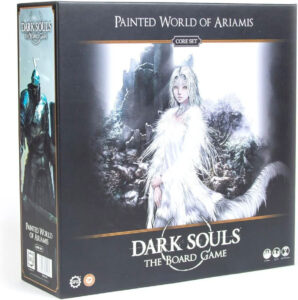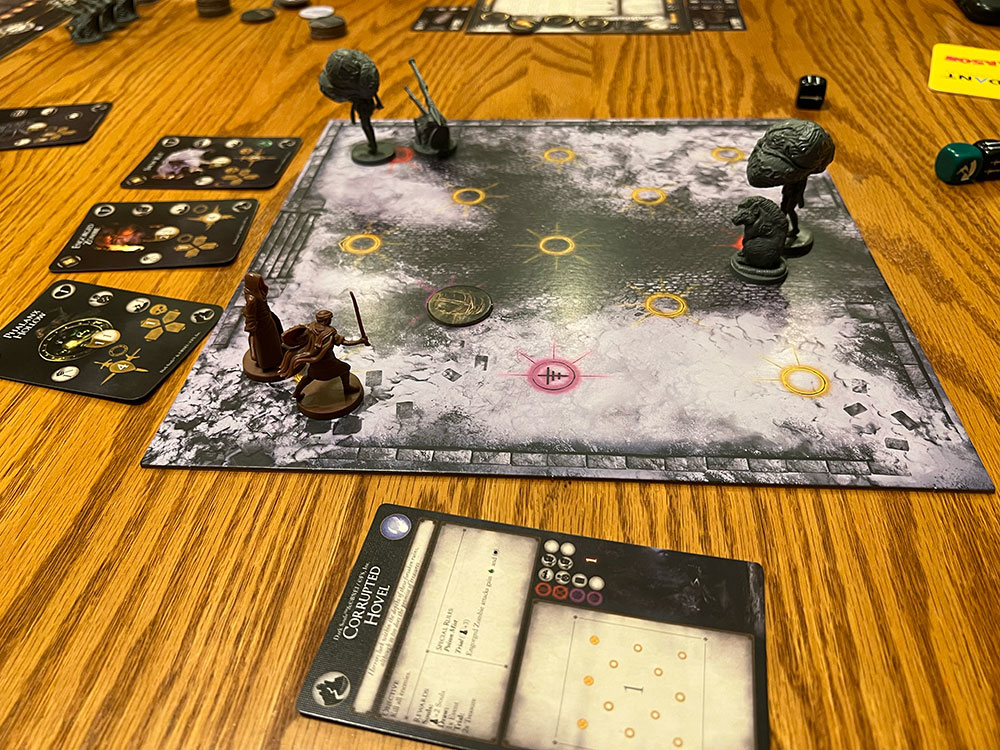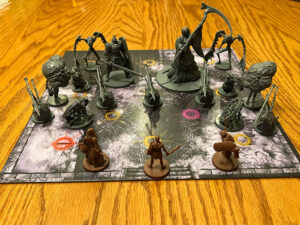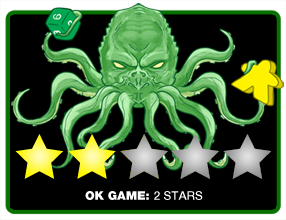 Hipster gamers might know Steamforged Games (SFG) because of Guild Ball, but the Dark Souls Kickstarter put them into the gaming spotlight. It funded in May of 2016 with $5.4 million in pledges, making it the twelfth-most funded project in the history of Kickstarter at that time.
Hipster gamers might know Steamforged Games (SFG) because of Guild Ball, but the Dark Souls Kickstarter put them into the gaming spotlight. It funded in May of 2016 with $5.4 million in pledges, making it the twelfth-most funded project in the history of Kickstarter at that time.
That was the high point for the Dark Souls game. The unexpected success led to stretch goal bloat, which led to increased design time and delays. The final product was released in multiple waves, with many gamers complaining about the printed ruleset, especially some of the design decisions and repetitiveness.
In September 2022, SFG announce they were revisiting the Dark Souls franchise by releasing two new core sets directly to retail. These two core sets would take place covering two new areas from the Dark Souls franchise not included in the original KS campaign—the Painted World of Ariamis and the Tomb of the Giants. Besides addressing issues from the first Kickstarter, SFG promised to include game changes made by the community as well as their own game-design tweaks for the new core sets. It also included a revised campaign mode designed to be backward compatible with existing Dark Souls products through future (and free!) card downloads from their website.
I was lucky enough to receive a copy of Painted World of Ariamis. I did not receive, nor have I played, Tomb of the Giants. Read on to find out my thoughts on the game!
NOTE: I have never played the original game, so this review will not focus on changes between the original campaign and this core set.
Gameplay Overview:
Dark Souls is a cooperative dungeon crawler for one to three players, with game length varying based on how well you perform (if you die, not so long) or if you grind (repeat levels to get more loot). It really is next to impossible to give an accurate estimate of game length.

The game is campaign-based and finds the players hunting down Crossbreed Priscilla, the final boss. The campaign steps are as follows:
- Players draw two encounters, choose one to face, adding it to the campaign dashboard, and then the other is shuffled back in the deck.
- The encounter is setup, with the game NPCs and players alternating turns, starting with the bad guys.
- Each encounter has a unique objective and there are 29 encounter cards, spread across three tiers, included in the game.
- The encounter is resolved.
- If the players completed the objective, they get the rewards, draw an event card, tilt the card to indicated the the encounter was completed, draw an event (30 are included in the game) and proceed to the next encounter.
- If they failed, they players return to the bonfire, spend a spark, and start over.
The game ends with either the players losing by running out of sparks or winning when they defeat Crossbreed Priscilla.

Game Experience:
I will not be discussing the encounter experience in detail, such as combat details, monster AI, or item cards. There are several other reviews that provide that detail. I want to focus on what I enjoyed and what I did not.
What made me grind more in Dark Souls
I really enjoyed the campaign and encounter system. The campaign FEELS like Dark Souls. You go into encounters having no idea what to expect. You can grind those encounters again, now knowing what you need to do and for a chance at additional loot at the expense of time. That push-your-luck is the quintessential feeling of Dark Souls. You can also find shortcuts that allow you to start over at the shortcut, instead of at the start of the track—this is the equivalent of finding a lever that unlocks a previously locked door in the video game. When you visit the bonfire, you can level up your stats and buy new equipment. Finally, defeating the miniboss (Heavy Knight) allows all future restarts to begin at the miniboss space on the encounter track instead of from the very beginning. Again, all of this is thematic to the source material.
I also enjoyed most of the encounters (see below). They are varied and give you something different to do or overcome. They are not all simply: “Kill X.” I really liked that some encounters had a second objective (called a Trial), which provided additional rewards if it was completed along with the main objective. Finally, I liked the Events that were included in the game. While not thematic to Dark Souls, these events can add modifiers to encounters, so you cannot be 100% sure how an already experienced encounter will play out. This is a perfect example of a design decision moving away from the source material to make a better game.

The game did not start off easy, but depending on your progress and luck with items, it could get easier as the game progressed, especially with replaying encounters. The boss fights were challenging and could get really hairy depending on which behavior cards came out. Overall, I enjoyed the game’s pacing from start to finish, but I do not enjoy impossible cooperative games.
Finally, the minis are excellent. They look like their in-game counterparts. I just wish there were….more.
What made me wish I was playing any other dungeon crawler
Unfortunately, the bad outweighed the good in the Painted World of Ariamis.
Most shocking to me was the number of errors in the rulebooks and cards that managed to make it through production. Incorrect card counts for the treasure deck (pg. 5). A weapon card in the space of an armor card (pg. 10). Trap tokens and Heroic Action tokens with misprints. Two encounter cards with misprints. That is off the top of my head. I know there are more. I thought that SFG would invest extra time and manpower into making sure the game was accurate and 99% error free; unfortunately, that is not the case.

They have posted an errata list on their website, but it does not cover every error that has been found. Additionally, cards to make the original game compatible with the new campaign format, promised to be released starting in Q1 2023, have not yet been released. Finally, symbols for each class are placed in the top right corner of treasure cards to determine who can utilize that equipment. In a decision I still do not understand, the character symbols, which are white, were placed on a white icon. My old eyes had a really difficult time discerning which character could equip which items without a magnifying glass.
Second, the game is expensive at $110, not including the cost of shipping, from the SFG webstore. The game includes three player-character minis, and 15 enemy minis, including two boss minis. That is a total of 18 minis with 10 being unique.
That’s it.

Now, not wanting to get into a debate about game quality or CMON vs. SFG, let’s look at Bloodborne by CMON. It is also a board game based on a video game and has the same $110 MSRP. It includes 37 minis, of which 16 are unique, including four bosses, with one having two unique forms. In addition, Bloodborne includes considerably more cards than Dark Souls due to its campaign format. Most importantly, it includes four player characters.
If you want to do that with Dark Souls, you will need to buy the second core box to have access to the fourth unique player character. I am sure this was a design decision to save costs on the set, one fewer mini and fewer cards to include. For consumers with a gaming group that is normally four players, you have two choices: skip Dark Souls or spend $220.
Another questionable design decision was the player boards. Characters have a base stat and can level up as high as Tier 3, so there are four columns. There are four stats to track, so each character has a 4 x 4 grid for their stats. Each of the 16 slots has a cardboard chit that is double sided with the same number. One is gold (this indicates that it has been earned) and one is barely not gold (my old eyes strike again!). When a character levels up a stat, you are supposed to punch out the chit and flip it to its gold side. I hope all of the previously punched out chits don’t fall out when you lift the player board…. We simply took cubes from a different game and put them in the active slot and kept the numbered token near.
Finally, some of the encounters are not balanced (Yay! A gameplay issue!). I do not expect all encounters to be balanced; however, we found a couple that resulted in an auto-win or auto-loss depending on setup and the encounter’s objective. This was not a serious issue for me (except for that one auto-loss), but I just wanted to make you aware that you could come across an aggravating encounter or two.
Final Thoughts:
I was disappointed in Dark Souls. The gameplay itself was decent; however, SFG was supposed to use this rerelease to revitalize interest in the Dark Souls board game and address the quality-control issues that customers have complained about. Unfortunately, it did not work out too well.
I really want SFG to succeed. I LOVE Monster Hunter, Resident Evil 3, and Bardsung. Monster Hunter and Bardsung had errata issues; however, their excellent gameplay overcame the errata. In my opinion, Dark Souls does not.
Final Score: 2 Stars – A second pass at Dark Souls that addressed some issues while bafflingly retaining old issues and creating new ones
 Hits:
Hits:
• Campaign and Encounter system
• Excellent minis true to Dark Souls
Misses:
• Too many typos/errata/rulebook issues
• Not enough variety in minis for the cost
• Supports only up to three players
• New player boards are terrible
• Encounter balance






















uff great strike